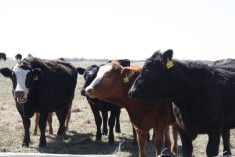This cattle market information is selected from the weekly report from Canfax, a division of the Canadian Cattlemen’s Association. More market information, analysis and statistics are available by becoming a Canfax subscriber by calling 403-275-5110 or at www.canfax.ca.
Calf run reaching peak
Auction market volumes have probably peaked for the fall run and should moderate. Over the next couple of weeks, premiums should be offered for pre-conditioned calves.
Prices for calves weighing 500-600 pounds have been dipping since the beginning of October and are trading at the lowest point since last April. If western Canadian calves drop much more, American interest may pick up.
Read Also

Why feds imposed EV tariffs
Moe and Kinew have a fight on their hands when it comes to eliminating the EV tariff. Canada has to worry about pissing off the U.S. and Mexico and hundreds of thousands of auto workers.
Canadian calf prices are sitting at a $13 per hundredweight discount to the South Dakota market. Canadian feeder exports have picked up and last week more than 3,700 head were sold. So far this year, more than 166,000 feeders have been exported.
Steer calf price averages for the 500-600 lb. category were $210.90 per hundredweight in British Columbia while Alberta steers averaged $216.27 per cwt. Saskatchewan and Manitoba were a dollar lower. Ontario steers averaged $218.67. All prices for western steers are down by 17 percent compared to last year at this time.
Fed cattle down
Alberta direct cattle sales continued to struggle with ample supplies and heavy carcass weights coming in at more than 920 lb.
Live prices trended mostly steady with last week from $147-$148.75 per cwt. Dressed sales were $248 per cwt., down from last week.
Packers appear to have sufficient inventory for the next three to four weeks but U.S. packer supplies have tightened so some American interest has emerged.
Western Canadian slaughter was down 11 percent from last week at 38,520 head. So far this year, kill numbers are up from 2017 at 1.6 million head.
Slaughter steers, heifers and cow exports to the U.S. totalled 304,800 so far this year.
Feedlot profitability
Margins for the feedlot sector this year have been mostly negative but some cattle yielded a profit at certain times of the year.
Many of the fed cattle had a break even in the mid $150 per cwt. but recent prices have been $148 per cwt. This results in a $100 per head loss.
Break-evens are expected to climb even higher to $165 per cwt. by the beginning of 2019.
Higher break-evens add risk to the feeding sector and ultimately affect the feeder markets if feedlots continue to sell cattle at a loss.
Cow market shaky
The cow market continues to shift downward. This is the 48th consecutive week where D2 cows have been below year-ago levels. For the first half of 2018, cow prices have averaged more than $7 per cwt. below last year.
D2 cows averaged $81.08 per cwt. in the western market, while the Ontario market was hovering around $54.57 per cwt. Rail grade prices were $155-$158 per cwt.
Large cow numbers are reported at commercial auction facilities due to drought. Some may be placed on feed for processing in the new year.
Beef trade stronger
U.S. Choice cut-out values surged higher this week to trade at the highest level since June. Demand was moderate to good on a light to moderate offering.
Choice rib was $7 per cwt. higher than last week while Select cuts were $1.70 per cwt. lower. Choice loin was up $9 per cwt.
Fresh 50 percent trim had moderate to good demand and prices trended sharply higher on this week’s smaller offering. The 73 percent trim market was $4.72 per cwt. higher.
U.S. beef production up
U.S. beef production is up 2.7 percent from last year and prices are trending steady.
Feeder and stocker prices traded mostly steady to lower than last week. In the coming weeks, prices are expected to trend mostly steady even with a large calf crop available and more feeder heifers coming to market.
Grains
Lethbridge corn averaged $246.87 per tonne while barley ranged from $233-$250 per tonne. Feed wheat was $231-$250. Ontario corn was $177.15 but barley was up to $280 per tonne.














